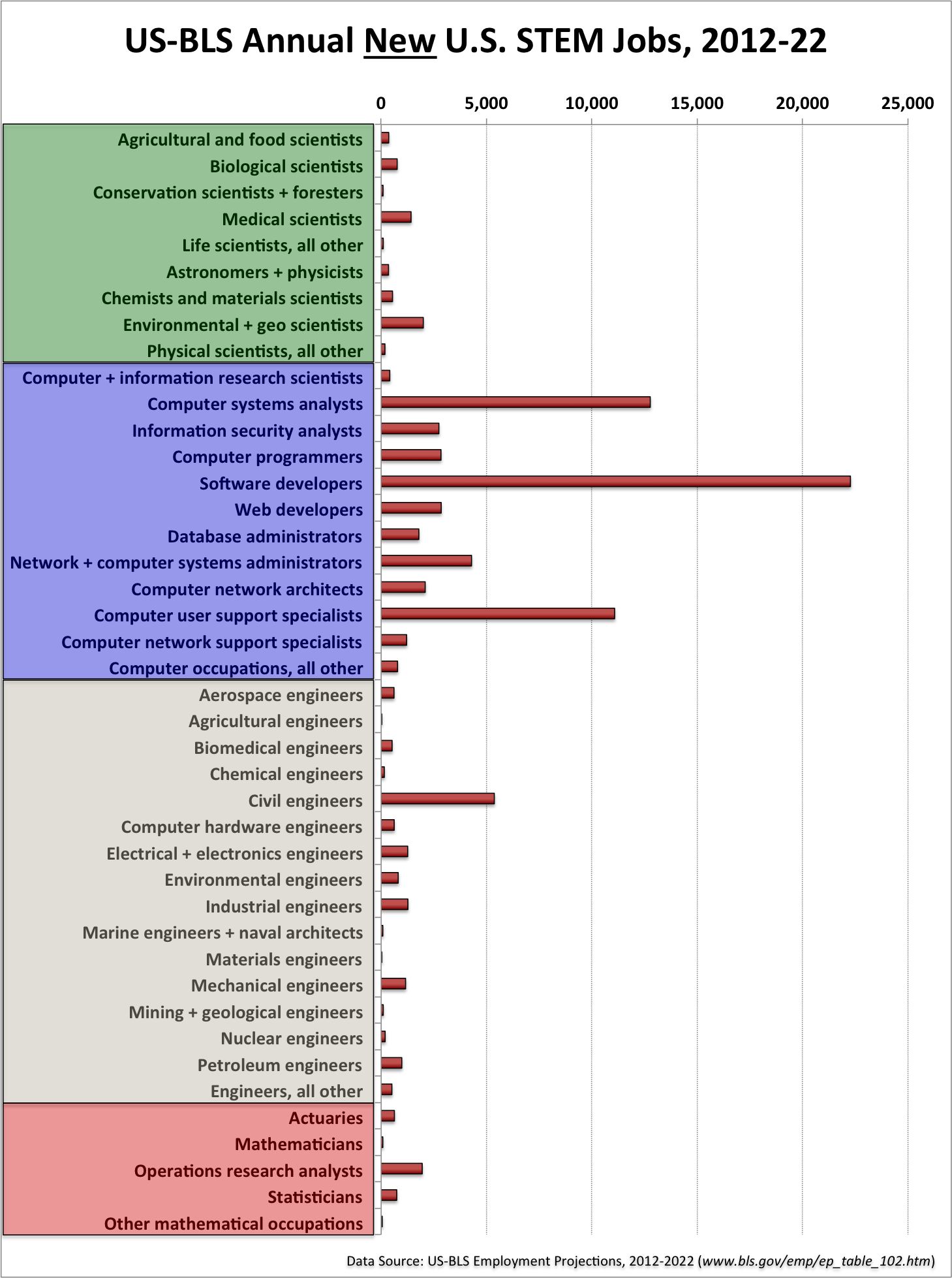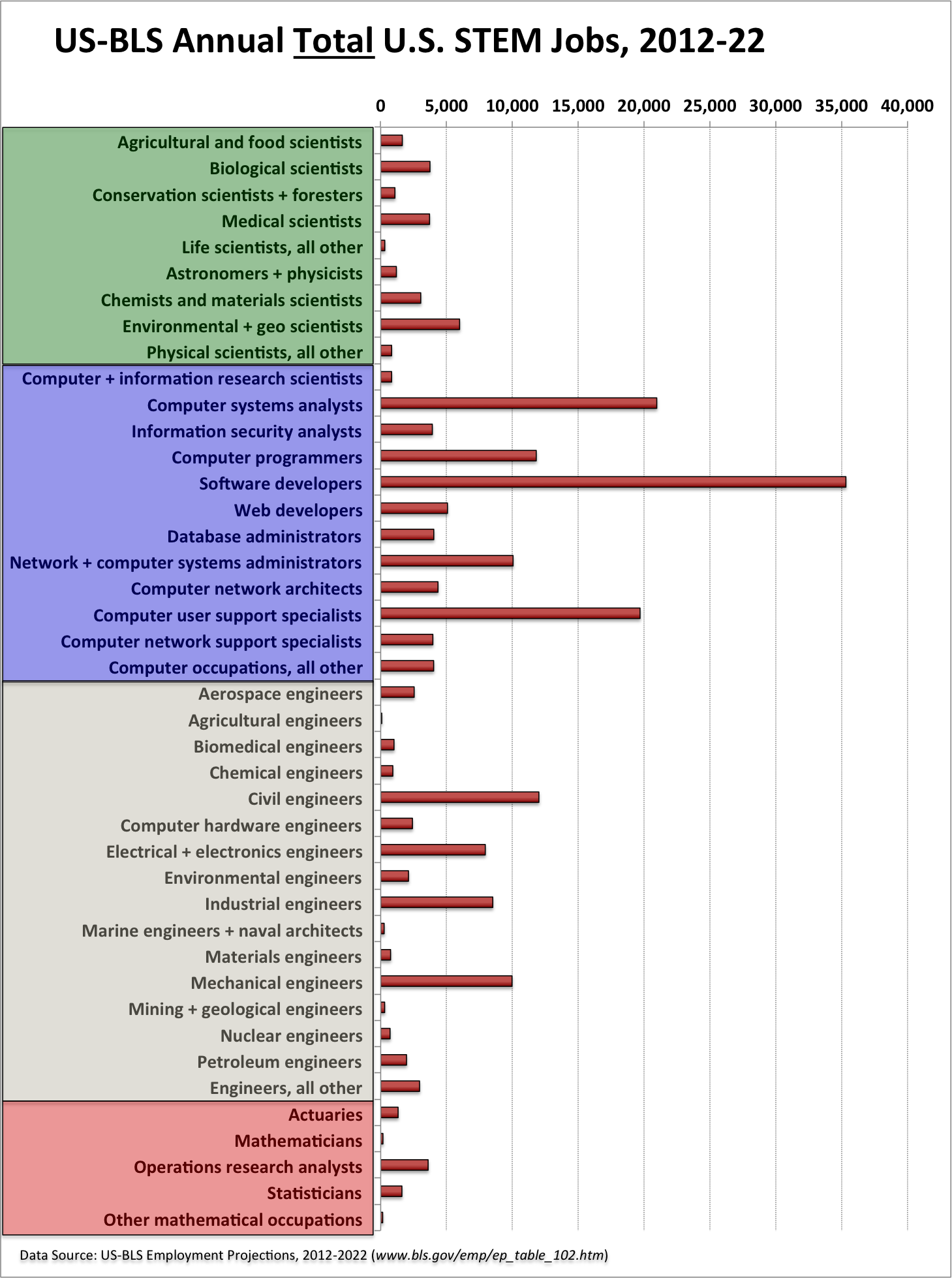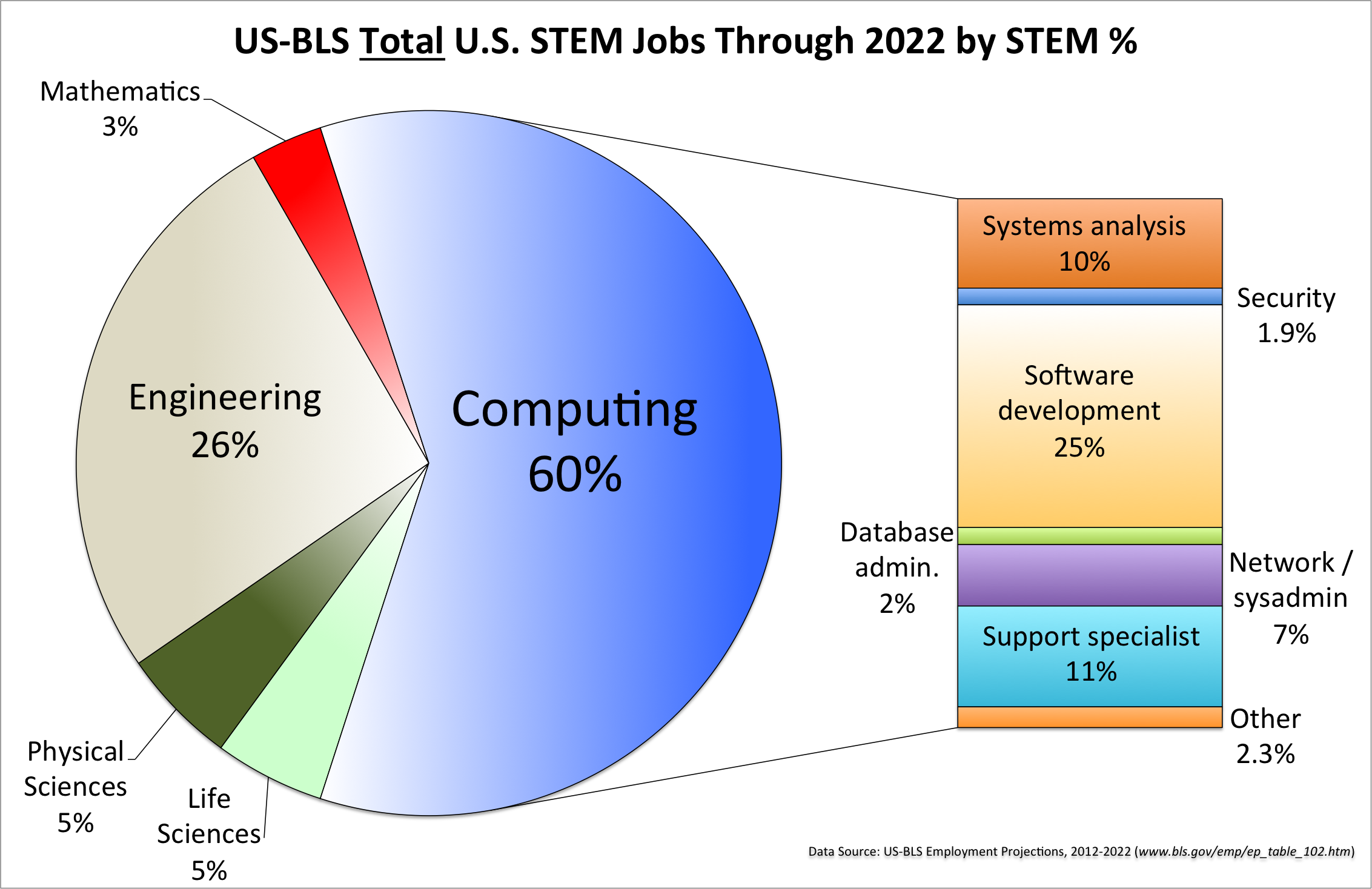

There are lots of myths about computing careers. One of the most ridiculous is the myth that computing careers are somehow "unsafe", while other science, technology, engineering, and mathematics (STEM) jobs are "safe". While the future is always tricky to predict, let's see what the best available data has to say about what careers are "safe" vs. "unsafe".
The best available source of data on the U.S. job market is the U.S. Bureau of Labor Statistics (US-BLS). Every two years, the US-BLS produces two sets of employment projections for the next decade:

|

|
(Click on either chart for a larger image.)
As you can see from the chart on the left, the US government predicts that the STEM jobs with the most growth will all be in computing; only one other area (civil engineering) is expected to generate more than 5000 new jobs per year. By contrast, the US-BLS predicts there will be over 22,000 new software development jobs, over 12,500 new systems analysts jobs, and over 11,000 new computing support jobs. The US-BLS also predicts good growth in the number of computer security analysts, programmers, and network and system administrators.
In light of the chart on the left, the chart on the right indicates that there will be some jobs in non-computing STEM areas, but that most of those jobs will be replacing retiring baby boomers, not new jobs created by economic growth.
If we aggregate these US-BLS projections as percentages by STEM area, we get the following charts:

|

|
(Click on either chart for a larger image.)
For the foreseeable future of science, technology, engineering, and mathematics jobs in the US, nearly 3 out of 4 new job openings and 3 out of 5 total job openings are going to be in computing! It is worth mentioning that this is not a fluke -- all of these numbers are fairly consistent with those from from two years ago.
What kind of "computing" careers are these? The bar-chart on the right breaks down the "computing" job openings into the different career categories, and shows the variety of careers that are available for students who study computing. As can be seen in the chart on the left, the US-BLS is predicting that 32% of the new STEM jobs will be in software development (aka software engineering) alone as compared to 16% in the combined branches of traditional engineering! With respect to total jobs, the chart on the right predicts that there will be nearly as many openings in software development as there will be in all the branches of traditional engineering combined.
Why will there be so many software development/engineering jobs? One reason is the mobile computing market. It used to be that every company wanted a website (and they still do), creating demand for web developers. But today, most companies also want native apps for the iPhone and iPad (which run Apple's iOS operating system) and for all the phones and tablets running Google's Android operating system, creating a huge demand for software developers.
Another reason is that manufacturers are increasingly embedding computers into appliances like refridgerators, ovens, water heaters, and so on; creating the so-called Internet of Things. All of these embedded computers will require software to do anything useful, creating even more demand for software developers. These computers will send data across the Internet, and this data will be stored in databases, creating demand for networking professionals and database administrators. When things go wrong, people will need technical support, creating demand for support specialists. Together, these are creating a huge demand for people with advanced computing skills, especially in software development.
Note that basic computer literacy (i.e., knowing Microsoft Word, Excel, or Powerpoint) or CAD-design skills will not qualify you for one of these jobs. Most of these jobs will require advanced computing skills that you will only gain by studying computer science, information systems, and/or software engineering.
With all of these jobs out there, you'd expect students to be flocking to computing. Until recently, the opposite has been true, as the following chart shows:
(Click on the chart for a larger image.)So the demand for computing-related professionals is exploding, but until recently, fewer students have been choosing to study the subjects needed to pursue these careers. And while more students have been studying computer science since 2009, the supply of CS graduates is still just a fraction of the demand for them.
To see this supply-demand imbalance, our final chart compares the US-BLS Total Jobs projections in the various STEM categories against the most recent National Science Foundation (NSF) data on the number of bachelors degrees being awarded in those categories:
(Click on the chart for a larger image.)
The yellow bars indicate the total number of job openings projected in each area per year, and the orange bars indicate the current number of graduates in those areas. In engineering, the sciences, and mathematics, the US is producing more graduates than there are jobs. If graduation levels remain the same, this means the graduates from these programs will be competing for the available jobs, which tends to keep salaries flat.
But in computing, there is a huge undersupply of graduates. As in any situation where demand exceeds supply, companies are competing for the (relatively few) available graduates that have advanced computing skills, driving salaries up. This is creating a huge demand for people with modern computing skills, as they have a wealth of job openings and career options from which to choose.
This huge demand is already happening, as evidenced by the "insane" salaries some Silicon Valley companies are paying their interns! In short, these companies are competing for a scarce resource -- people with advanced computing skills -- while non-computing STEM grads are competing for a different scarce resource -- jobs in their discipline.
Here in west Michigan, things are not quite so "insane", but in a typical week, we do receive multiple requests from companies or individuals seeking student interns. These include both full-time positions and (mostly paid) student internships. The average wage for the paid internships is about $15/hr.
So why is computing the "safe" career option? Because in the 21st century, computing technology (especially software) controls much of our day-to-day lives, and people are needed to create and maintain that technology.
To prepare students for this century, Calvin's Department of Computer Science offers:
If God has gifted you with creative, logical, and/or quantitative abilities, He may be calling you to a career in computing. We invite you to join us -- we will do everything we can to help you explore that calling and develop your gifts.